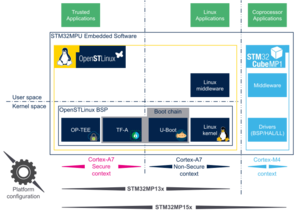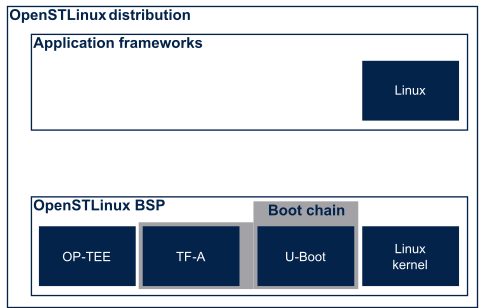Registered User No edit summary |
Registered User mNo edit summary |
||
| Line 19: | Line 19: | ||
rect 260 229 356 286 [[U-Boot overview]] | rect 260 229 356 286 [[U-Boot overview]] | ||
rect 364 229 461 287 [[STM32MP15 Linux kernel overview]] | rect 364 229 461 287 [[STM32MP15 Linux kernel overview]] | ||
poly 255 203 359 203 359 289 140 289 140 224 255 224 [[ | poly 255 203 359 203 359 289 140 289 140 224 255 224 [[Boot_chain_overview|Boot chain overview]] | ||
rect 32 198 469 296 [[OpenSTLinux BSP architecture overview]] | rect 32 198 469 296 [[OpenSTLinux BSP architecture overview]] | ||
rect 364 62 461 121 [[Linux application frameworks overview]] | rect 364 62 461 121 [[Linux application frameworks overview]] | ||
Revision as of 11:12, 25 September 2020
The OpenSTLinux distribution encompasses the following components:
- The OpenSTLinux BSP that offers services, to the application frameworks in the same context, from:
- The boot chain based on TF-A and U-Boot
- The OP-TEE secure OS running on the Cortex-A in secure mode
- The Linux® kernel running on the Arm® Cortex®-A in non-secure mode
- The Application frameworks that rely on the services provided by the OpenSTLinux BSP, to provide particular functionalities (code libraries, APIs, tool sets...) to facilitate the development of software applications:
- The Linux application frameworks (aka Linux middlewares) running on the user space of the Linux OS: e.g. libusb C library for a generic access to USB devices, ALSA user-space bundle for audio functionalities, GStreamer multimedia framework...
- The OP-TEE application frameworks running on the user space of the secure OS: e.g. TEE Internal core API for the development of Trusted Applications (TA)
- The U-Boot application frameworks: e.g. configuration scripts
The figure below is clickable so that the user can directly jump to one of the sub-levels listed above.

